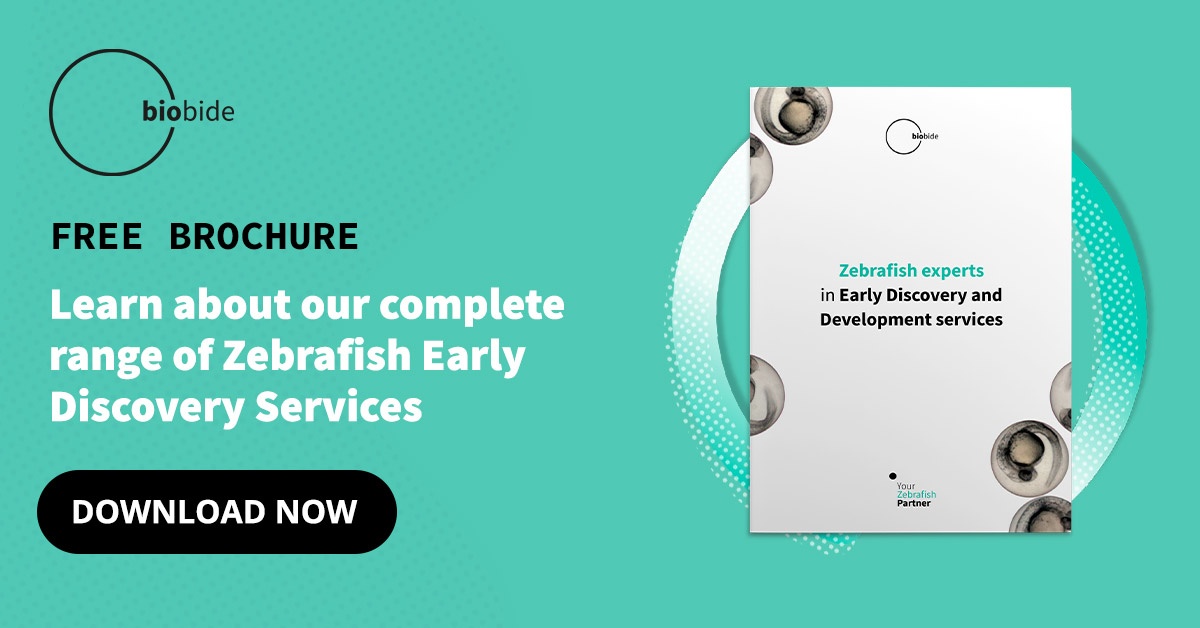The Hit-to-Lead (H2L) stage is one of the most essential stages in early Drug Discovery. In this article, we’ll explain everything you need to know about the H2L process, including the major stages and how Zebrafish can be used.
The Drug Discovery process naturally flows from target validation to clinical development, passing through the Hit-To-Lead stage. A hit is a term that describes a chemical compound that has a desired therapeutic effect at a known target molecule. The lead is the product of the screening process, which can be used in advanced stages.
The main aim of H2L is to find the appropriate leads to move along the pathway to a final clinically active drug. During the H2L stage, researchers refine the initial compounds using different screening methods, such as High Throughput Screening. The screening process aims to reduce the number of these compounds into less and more qualified leads using in vitro and computer-based approaches. The lead properties must be adequate to examine their efficacy in any in vivo models, including zebrafish.
Approaches to the Hit-To-Lead (H2L) process
In order to start the H2L process, we need to start identifying hit compounds. There are various approaches to find hit molecules. Researchers may use conventional High-Throughput Screening systems to identify hit compounds from thousands of compounds contained in a chemical library. Other ways involve affinity selection of huge chemical libraries, fragment-based approaches, and target-focused libraries. Researches can identify biologically active targets from newly experienced living organisms. They can use biotechnology and computer-aided structure-based approaches to control living systems to discover new possible hits.
Typically, the screening of the initial hits shows binding affinities to the targets in a micromolar range. Using H2L optimization, the hits’ binding affinities are usually improved compared to the nanomolar range. In addition, the H2L optimization improves metabolic half-life, making it possible to use animal models such as zebrafish. This will improve the selectivity towards binding different targets.
Hit Confirmation
The hit-to-lead stage starts with the confirmation and testing of the initial screening hits, succeeded by the synthesis of analogs in a step called hit expansion, which we will further explain later on in this article. The hits are tested and confirmed via various methods.
Confirmatory Testing means retesting the active compounds versus the biological target utilizing the same test situations used through High-Throughput Screening to assure the same activity.
Another testing method is the dose-response curve; the compound is examined across a limit of concentrations to define the concentration that produces half-maximal binding.
Orthogonal Tests are also used in an attempt to reduce exhaustive testing; validated hits are examined with a modified assay, usually one closer to the target’s physiological state, or using another technology.
Other confirmatory tests are secondary screenings and even synthetic tractability to foresee potential problems in production and costs.
The assessment of whether the compound will effectively bind to the target, the thermodynamics, stoichiometry, kinetics of the bond, or any conformational change is tested by the use of biophysical tests. Examples of biophysical tests include Buclear Magnetic Resonance (NMR), Dynamic Light Scattering (DLS), IsIothermal Titration Calorimetry (ITC), Double Polarization Interferometry (DPI), Microscale Thermophoresis (MST) and, Surface Plasmon Resonance (SPR).
Hit Expansion
Once the hit compounds are refined, researchers start to test their analogs in order to check the compound’s Structure-Activity Relationships (SAR).
SAR information is a major step in the expansion process. It is used to select and design improved structural analogs with better activity, and to confirm the main structures of the compound.
Zebrafish for Hit-To-Lead
Zebrafish have made big improvements in the field of Drug Discovery. Researches have been using this model because of a high degree of physiological and genetic similarities between mammals and zebrafish. Moreover, the large numbers and the fact that larvae are small-sized and transparent, make them rapidly assessed in High-Content Screening.
In addition, Zebrafish have stable genetic material, which allows correlating phenotypes with target binding via fluorescent assays. This makes zebrafish a strong tool to optimize, agonists and antagonists, and the generation of the compounds analogs. Zebrafish larvae are permeable to many small compounds, another property that allows the use of biochemical screening methods in the process of hit identification.
In the process of early Drug Discovery, it is essential to increase the hit-to-lead ratio and to decrease the dead-end compounds outcome. This can be achieved using the Zebrafish, due to their advantages as a living organism in the High-Content screening process. These advantages include lessening withdrawal compounds by using a meaningful whole organism system that help reduce final costs, and time.






